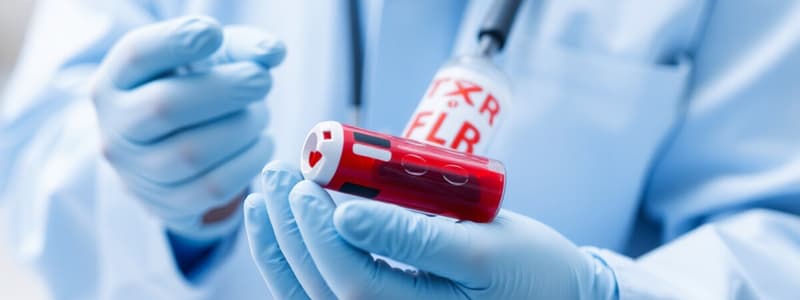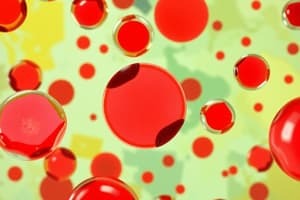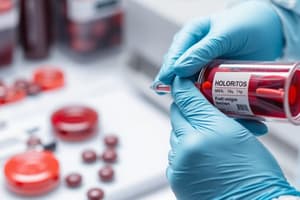Podcast
Questions and Answers
What role do medical technologists play in the blood banking process?
What role do medical technologists play in the blood banking process?
- Managing hospital budgets for blood products
- Managing the blood banking process (correct)
- Overseeing donor recruitment and public relations
- Performing blood collection from donors
Why is whole blood typically centrifuged during processing?
Why is whole blood typically centrifuged during processing?
- To extend its shelf life
- To activate clotting factors
- To remove any potential contaminants
- To separate it into various components (correct)
Which blood component is often removed to minimize the risk of reaction in the recipient, particularly febrile non-hemolytic transfusion reactions (FNHTR)?
Which blood component is often removed to minimize the risk of reaction in the recipient, particularly febrile non-hemolytic transfusion reactions (FNHTR)?
- Red blood cells
- Plasma
- White blood cells (correct)
- Platelets
What is the primary purpose of blood banking?
What is the primary purpose of blood banking?
What steps are involved in the general process of blood banking?
What steps are involved in the general process of blood banking?
What factors are typically assessed during the screening of a potential blood donor?
What factors are typically assessed during the screening of a potential blood donor?
What is the purpose of tracking blood bags and test tubes through barcodes during the donation process?
What is the purpose of tracking blood bags and test tubes through barcodes during the donation process?
For how long and at what temperature are bags of blood typically stored after testing is completed?
For how long and at what temperature are bags of blood typically stored after testing is completed?
While better blood management programs have reduced blood use in elective surgeries; what type of blood demand has remained constant, especially during emergencies?
While better blood management programs have reduced blood use in elective surgeries; what type of blood demand has remained constant, especially during emergencies?
What significant discovery was made by Karl Landsteiner in 1901 that revolutionized blood transfusions?
What significant discovery was made by Karl Landsteiner in 1901 that revolutionized blood transfusions?
What information do educational materials, such as the AABB pamphlet, provide to prospective blood donors?
What information do educational materials, such as the AABB pamphlet, provide to prospective blood donors?
What is the purpose of the donor health history questionnaire in the blood donation process?
What is the purpose of the donor health history questionnaire in the blood donation process?
What does the abbreviated physical examination for blood donors typically include?
What does the abbreviated physical examination for blood donors typically include?
What percentage of blood volume does plasma constitute?
What percentage of blood volume does plasma constitute?
How long do red blood cells typically circulate in the body before they are replaced?
How long do red blood cells typically circulate in the body before they are replaced?
What is the role of white blood cells in the blood?
What is the role of white blood cells in the blood?
What happens to platelets when a blood vessel is damaged?
What happens to platelets when a blood vessel is damaged?
What blood types are included in the eight common blood types?
What blood types are included in the eight common blood types?
Which blood type is considered the universal donor?
Which blood type is considered the universal donor?
If a patient has type A blood, which antibodies are present in their plasma?
If a patient has type A blood, which antibodies are present in their plasma?
What happens if incompatible blood types are mixed during a transfusion?
What happens if incompatible blood types are mixed during a transfusion?
Which infectious disease screening test was introduced for donor blood in 2016?
Which infectious disease screening test was introduced for donor blood in 2016?
Which of the following is a crucial aspect of RBC biology for normal erythrocyte survival and function?
Which of the following is a crucial aspect of RBC biology for normal erythrocyte survival and function?
What could result in RBCs surviving fewer than the normal 120 days in circulation?
What could result in RBCs surviving fewer than the normal 120 days in circulation?
Why is the RBC metabolism primarily anaerobic?
Why is the RBC metabolism primarily anaerobic?
Which of the following is the Embden-Meyerhof pathway responsible for in red blood cells (RBCs)?
Which of the following is the Embden-Meyerhof pathway responsible for in red blood cells (RBCs)?
What is the primary goal of RBC preservation methods?
What is the primary goal of RBC preservation methods?
How is blood viability maintained during storage?
How is blood viability maintained during storage?
How do additive solutions benefit RBC storage?
How do additive solutions benefit RBC storage?
What is one strategy being pursued in current research and development regarding platelet preservation?
What is one strategy being pursued in current research and development regarding platelet preservation?
What kind of session initiates the blood donation journey?
What kind of session initiates the blood donation journey?
How does blood donation cause the donor's naturally flow into a special bag?
How does blood donation cause the donor's naturally flow into a special bag?
Why is the blood bag gently rocked during the blood donation process?
Why is the blood bag gently rocked during the blood donation process?
What is the role of insulated containers in the labeling and transport step blood process?
What is the role of insulated containers in the labeling and transport step blood process?
What procedure is performed to remove white blood cells from donated blood?
What procedure is performed to remove white blood cells from donated blood?
What treatments do hospital labs perform to the blood sample?
What treatments do hospital labs perform to the blood sample?
What is the purpose of the readings provided about blood components in the overview?
What is the purpose of the readings provided about blood components in the overview?
What is the primary criterion for apheresis donors, beyond the standard whole blood donation requirements?
What is the primary criterion for apheresis donors, beyond the standard whole blood donation requirements?
In blood component separation, what is the primary reason for using a refrigerated centrifuge?
In blood component separation, what is the primary reason for using a refrigerated centrifuge?
What is the most critical consideration when deciding to transfuse blood components to a patient?
What is the most critical consideration when deciding to transfuse blood components to a patient?
How do additive solutions impact the characteristics of stored red blood cells (RBCs)?
How do additive solutions impact the characteristics of stored red blood cells (RBCs)?
Which of the following rationales best describes why blood bags should be gently rocked during blood collection?
Which of the following rationales best describes why blood bags should be gently rocked during blood collection?
Flashcards
Blood Bank
Blood Bank
A blood bank collects, separates, tests, and stores blood until needed by a patient.
Role of Medical Technologists in Blood Banking
Role of Medical Technologists in Blood Banking
Medical technologists are responsible for the blood banking process.
Blood Banking
Blood Banking
Blood banking ensures donated blood/products are safe for transfusions and medical procedures.
Screening (Blood Banking)
Screening (Blood Banking)
Signup and view all the flashcards
Testing and Processing
Testing and Processing
Signup and view all the flashcards
Storage (Blood)
Storage (Blood)
Signup and view all the flashcards
Distribution (Blood)
Distribution (Blood)
Signup and view all the flashcards
Transfusion (Blood)
Transfusion (Blood)
Signup and view all the flashcards
Screening (Blood Donation)
Screening (Blood Donation)
Signup and view all the flashcards
Donation
Donation
Signup and view all the flashcards
Processing (Blood)
Processing (Blood)
Signup and view all the flashcards
Karl Landsteiner
Karl Landsteiner
Signup and view all the flashcards
Patient Education
Patient Education
Signup and view all the flashcards
Donor Health History Questionnaire
Donor Health History Questionnaire
Signup and view all the flashcards
Physical Examination
Physical Examination
Signup and view all the flashcards
Plasma
Plasma
Signup and view all the flashcards
Red Blood Cells (Erythrocytes)
Red Blood Cells (Erythrocytes)
Signup and view all the flashcards
White Blood Cells (Leukocytes)
White Blood Cells (Leukocytes)
Signup and view all the flashcards
Platelets
Platelets
Signup and view all the flashcards
Blood Types
Blood Types
Signup and view all the flashcards
Blood Donor
Blood Donor
Signup and view all the flashcards
What determines the type of blood a person has?
What determines the type of blood a person has?
Signup and view all the flashcards
Antibodies in blood
Antibodies in blood
Signup and view all the flashcards
Rh Typing
Rh Typing
Signup and view all the flashcards
Incompatible Transfusion
Incompatible Transfusion
Signup and view all the flashcards
Diseases Screened for in Donated Blood
Diseases Screened for in Donated Blood
Signup and view all the flashcards
Irradiation Blood
Irradiation Blood
Signup and view all the flashcards
Leukocyte-Reduced Blood
Leukocyte-Reduced Blood
Signup and view all the flashcards
Embden-Meyerhof Pathway
Embden-Meyerhof Pathway
Signup and view all the flashcards
Pentose Phosphate Pathway
Pentose Phosphate Pathway
Signup and view all the flashcards
RBC Preservation
RBC Preservation
Signup and view all the flashcards
RBC Viability
RBC Viability
Signup and view all the flashcards
Liquid State
Liquid State
Signup and view all the flashcards
Storage Lesions
Storage Lesions
Signup and view all the flashcards
Anticoagulant Preservative Solutions
Anticoagulant Preservative Solutions
Signup and view all the flashcards
RBC Additive Solutions
RBC Additive Solutions
Signup and view all the flashcards
Blood Pharming
Blood Pharming
Signup and view all the flashcards
Platelets
Platelets
Signup and view all the flashcards
Leukodepletion
Leukodepletion
Signup and view all the flashcards
Blood Testing
Blood Testing
Signup and view all the flashcards
Single-step Heavy Spin
Single-step Heavy Spin
Signup and view all the flashcards
Leucodepletion
Leucodepletion
Signup and view all the flashcards
Apheresis
Apheresis
Signup and view all the flashcards
Photopheresis
Photopheresis
Signup and view all the flashcards
Frozen Red Cell Concentrate
Frozen Red Cell Concentrate
Signup and view all the flashcards
Study Notes
Overview of Blood Banking
- Blood banking involves collecting, separating, testing, and storing blood for patients in need
- Medical technologists oversee the blood banking process
- Blood collection from donors is the initial step
- Donated blood undergoes processing, typically through centrifugation
- Whole blood is separated into components such as red blood cells, platelets, and plasma during processing
- White blood cells are usually removed to reduce potential recipient reactions
Blood Banking
- Ensures the safety of donated blood and blood products before use in transfusions or medical procedures
- Transfusions are often needed for trauma patients (e.g., car accidents) or those with low platelet counts
- Blood typing and testing for infectious diseases are crucial in blood banking
General Process of Blood Banking
- Screening: Staff evaluate a donor's health history and conduct a mini physical, including checking blood iron levels
- Only patients who successfully complete the screening may donate
- Donation: A standard donation consists of approximately one pint of blood and several small test tubes
- The bag and test tubes are barcoded and sent to separate facilities for tracking
- Testing and Processing: The test tubes are screened for infectious diseases in a testing laboratory
- The bag undergoes processing at a center, where whole blood is separated into red cells, platelets, and plasma via centrifuges
- Storage: Suitably tested and labeled blood bags can be stored in refrigerators (43°F) for up to 42 days
- Distribution: While hospitals maintain some blood bags, they mostly order from blood centers as needed
- Transfusion: Universal blood is still preferred with reduced usage in elective surgeries, due to effective blood management programs
History of Blood Banking
- 1942: Blood group antigens and blood type incompatibilities caused many early transfusions to be fatal
- 1869: Braxton Hicks suggested sodium phosphate as an anticoagulant
- 1901: Karl Landsteiner discovered ABO blood groups, explaining transfusion reactions, and he later received a Nobel Prize for it
- First Successful vein-to-vein transfusions used multiple syringes and a special cannula
- Preservation solutions were subsequently created to improve the length of time blood could be stored
- 1941: The first blood bank in the US was established
Current Status - The Donation Process
- Step 1: Provide educational materials to prospective donors
- Materials include risks of infectious diseases transmitted by blood, with emphasis on AIDS symptoms
- Step 2: Completion of a Donor Health History Questionnaire
- The questionnaire screens for exposure to diseases transmittable in blood such as Creutzfeldt-Jakob, West Nile virus, malaria, or Chagas disease
- Step 3: Perform An Abbreviated Physical Examination which includes:
- Includes measuring blood pressure, temperature, hemoglobin/hematocrit and physical inspection of the arms
Blood Components
- Plasma:
- Is the yellowish, liquid part of blood
- Composes about 55% of blood
- Contains water, salts, antibodies, enzymes, and other proteins
- Red blood cells (erythrocytes):
- Comprises about 45% of blood
- It contains Hemoglobin, which binds to oxygen
- Lives for about 120 days, and are produced everyday in the bone marrow
- White blood cells (leukocytes):
- They are the cells of the immune system
- Protects from foreign invaders and infectious diseases
- Derived from hematopoietic stem cells in the bone marrow
- Platelets:
- When there is damage to blood vessels, signals send platelets to repair the area of injury
How Blood Flows
- Oxygen then passes through the capillaries of the lungs into the blood during breathing
- Next, oxygen-rich blood flows through the pulmonary veins to the left chamber of the heart. Blood is then sent out of the aorta to the entire body
Other Important Information
- There are 8 blood types: A+, A-, B+, B-, O+, O-, AB+, AB-
- Healthy food choices like dry fruits, green vegetables,beans, whole grains and low-fat dairy is essential to healthy blood
What to know about Blood Donors
- Must meet the age requirement (at least 16 years of age, or in accordance with state law)
- Must be in good health
- Must weigh at least 110 pounds
- Must pass the physical and health history exam given before donation
- Some countries permit people younger than 16 or 17 years to donate blood, with parental consent
Blood Typing Tests
- ABO group
- Rh Typing
- Screening for unexpected red blood cell antibodies
Blood Screening Tests
- Tests year required-
- Syphilis- 1950s
- Hepatitis B Surface Antigen- 1971
- Hepatitis B Core Antibody- 1986
- Hepatitis C Virus Antibody- 1990
- Human Immunodeficiency Virus Antibodies- 1992
- Human T-Cell Lymphotropic Virus Antibody- 1997
- Human Immunodeficiency Virus- 1999
- Hepatitis C Virus (HCV) NAT- 1999
- West Nile Virus NAT- 2004
- Trypanosoma cruzi Antibody- 2007
- Hepatitis B Virus- 2009
- Babesia Microti Antibody- 2012
- Zika Virus NAT- 2016
RBC Biology and Preservation
- Crucial parts for the erythrocyte survival are the structures of the RBC membranes, hemoglobin, and metabolism
- Any impairment will lead to RBCs surviving less than 120 days
- For instance, sickle cell anemia leads to the RBC losing flexibility, which leads to agglutination
RBC Metabolism
- ATP production is primarily anaerobic, to deliver oxygen
- Mature RBCs do not have a nucleus and mitochondria- energy must be produced glucose breakdown
- The main pathway(90% of ATP): Embden-Meyerhof Pathway (Anaerobic glycolytic pathway)
- Three ancillary pathways:
- Pentose phosphate pathway - Provides 10% of ATP
- Methemoglobin reductase pathway
- Luebering-Rapoport shunt - accumulate 2,3-diP-Glycerate metabolite
RBC Preservation
- Preservation must be done to ensure that viable units of blood are on hand for patient transfusions
- The measure of survivability is observed in vivo in RBC survivals
- From the time of donation to transfusion, blood is stored in the liquid state between 1°C to 6°C
- Storage time is determined by preservative solutions used
- The losses of RBC viability have been correlated to various biochemical changes
- Commonly observed RBC characteristics include:
- Viable Cells (%) Decrease
- Glucose Decrease
- ATP Decrease
- Lactic Acid Increase
- pH Decrease
- Oxygen dissociation curve Shift to the left (increase in hemoglobin and oxygen affinity; less oxygen delivered to tissues)
- Plasma K+ Increase
- Plasma Hemoglobin Increase
Anticoagulant Preservative Solutions
- Along with the anticoagulant preservative CPD, different chemicals were incorporated to boost glycolysis to maximize ATP levels
Additive Solutions
- Preservative solutions are added to the RBCs, without platelets or the plasma
- This removes most of the nutrients needed to maintain RBCs
- This extends the shelf life of RBCs to 42 days, and allows for more harvesting of plasma and platelets.
- Also creates a lower level viscosity unit for easier transfusions
Platelet Preservation
- Yearly, roughly 2.4 million units of platelets administered transfusions, and 2.2 units were distributed
- Platelets promote and prevent blood coagulation
- The store temperature for Platelets is between 20oC to 24oC while maintaining constant agitation
- Loss of quality occurs while being stored
- Assessments are made immediately before distribution, with special emphasis on platelet swirl (no visible aggregation)
Clinical Use of Platelets
- Use cases include resolving thrombocytopenia or dysfunctional platelets
- Platelets can be created as concentrates from whole blood or through apharesis
- Pathogen inactivation is one of the procedures developed for reducing and deactivating pathogens on platelet components
The Journey of Blood
- The journey of each bag of blood involves many people, many processes, a fleet of vehicles, and some fascinating science, resulting in patients’ lives being saved
- The journey of blood starts once someone decides to donate their blood
Donor Center
- Blood donation session includes a health screening and iron test, which will determine one’s eligibility to donate
- To protect the health of both the blood donor and the patient (blood recipient)
- If eligible, the donor team will start the donation
Blood Donation Process
- Donor's blood will naturally flow into a special bag that contains an anticoagulant to stop it from clotting
- It gently rocks to make sure the anticoagulant mixes through the whole bag
- The blood donation part takes about 5 to 10 minutes
- Aside from the main blood bag, a few sample tubes will also be filled for testing
- All in all, around 470 milliliters of blood will be taken (or just under an average bottle of water)
- The whole blood donation process only takes around an hour
Replenishment
- The body will replenish this volume in 24 to 48 hours
- Blood is made up of several components such as plasma, platelets, and red cells
- The body makes about 2 million new red cells every second, so it only takes a few weeks to build up stores of them again
- The first step to this replenishment is helping yourself to a well-deserved drink and snack
Labelling and Transport
- The blood bag and sample tubes will be labeled with the same unique donation number and barcode to link them together
- The barcode is unique to each donation so it can be traced at every single stage of the process
- The labelled donation will then be packed into insulated containers to protect it and maintain the temperature and quality of the blood
- The transport drivers then collect the blood from that day's session, taking it to the blood processing lab
- Around 5,000 units of blood are donated daily
- While donation goes off to the labs for processing, your donor safety check goes to our donor records, and the samples taken with your donation go to the testing labs.
Studying That Suits You
Use AI to generate personalized quizzes and flashcards to suit your learning preferences.




